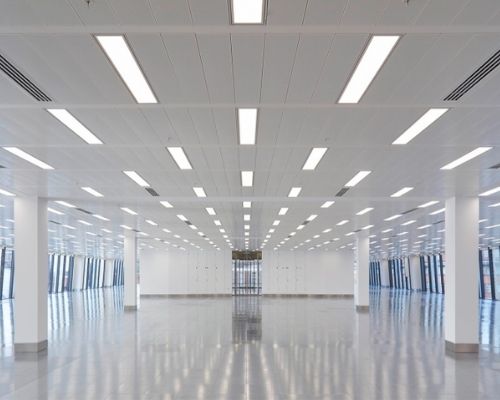LED Lighting

LED Lighting "Improving your Carbon Footprint and Saving your Business Money"
Energy Efficiency
Leds use up to 75% less electricity than incandescent bulbs, resulting in substantial energy cost savings, especially for any business with lights that are on for extended periods. Leds also emit light in a specific direction unlike incandescent and compact fluorescent bulbs, which emit light—and heat—in all directions. This directional lighting capability reduces wasted light and energy. See this DOE fact sheet for more on comparing LED
Extended Lifetime
Unlike incandescent lighting, LEDs don’t “burn out” or fail, they merely dim over time. Quality LEDs have a life of 30,000 – 50,000 hours or even longer, depending on the quality of the light fixture. A typical incandescent lamp lasts only about 1,000 hours; a comparable compact fluorescent lasts 8,000 to 10,000 hours. With a longer operational life, LEDs can reduce labor costs of replacing bulbs in commercial situations, achieving a low maintenance lighting system.
Durability
Without filaments or glass enclosures, LEDs are breakage resistant and largely immune to vibrations and other impacts. Traditional lighting is usually contained in a glass or quartz exterior which can be susceptible to damage depending on the application.
RAPID CYCLING CAPACITY
A high on-off frequency can cause traditional lighting to burn out faster, whereas LEDs are unaffected by rapid cycling. For this reason, LEDs are an effective option for occupancy or daylight sensor lighting.
No IR or UV Emissions
Less than 10% of the power used by incandescent lamps is actually converted to visible light; the majority of the power is converted into infrared (IR) or radiated heat. Excessive heat and ultraviolet radiation (UV) presents a burn hazard to people and materials. LEDs emit virtually no IR or UV.
Rapid advancements in LED lighting technologies, with more improvements on the horizon, have resulted in lowered costs and increased reliability of LEDs. While it may be tempting to assume LEDs are the right choice for all applications, lighting selection should be based on a number of factors: energy efficiency, color quality, light distribution, dimmability, and expected lifetime. The DOE offers various resources to help guide your decision.
Asset Finance for your LED Lighting Installation
Using Energy Efficiency asset financing to pay for your LED Lighting Installation is one of the smartest business decisions trending at present. Keep your own capital in the business and use your energy savings to pay for your LED Lighting
The Advantages of Asset Finance for LED Lighting
Asset finance refers to an opportunity where a business can obtain financing when they purchase a new asset and the asset is then used as security against the lending. The 2 most common types of asset finance are hire purchase and lease finance. The term “asset” can refer to a number of different items and is most popular with businesses who want to purchase vehicles/equipment.
This is an overview of some of the key benefits of asset finance. We also look at why it is such a popular option for businesses that require equipment, but do not necessarily have the capital to purchase these assets in full.
Why Use Asset Finance?
One of the most obvious and best advantage of using asset finance is that it provides a business with a way to purchase new LED lighting that they may not have been able to afford if payments were not spread out. This will have a number of benefits, including increased efficiency energy savings of a minimum of 50%.
More Flexibility
Following on from the recent economic recession and the subsequent legislation which has made banks’ lending criteria even more stringent, many businesses who do not “tick all the boxes” are finding it very difficult to secure funding from the banks.
There may be a number of reasons why a business does not have a perfect credit history and, as everyone’s situation is different, a good asset finance business will judge each finance application on its own merit.
The finance company will, of course, always have their own lending criteria that must be met by any business they lend to, but you can generally expect more flexibility than you would get from a bank.
Good for Cash Flow
One of the reasons that asset finance is a popular financing option is because payments are spread out over an agreed term, which frees up working capital.
A typical term is between 2-5 years, as this is generally the kind of time-frame that allows businesses to make manageable monthly payments and also means that lighting can be either replaced at the end of the agreed term or title can be transferred for a minimal cost of around 2% of the project cost.
Companies that have more capital available up front often favour hire purchase whereby title to the asset transfers to the company at the end of the payment term, as strong cash flow enables them to pay the VAT due on the asset that must be paid up front, whereas companies for whom cash flow is more of an issue often favour leasing, as VAT is only payable on the monthly rentals over the terms of the agreement.
Tax Benefits Through Capital Allowances
“Capital allowances” refer to financial deductions available to UK businesses on their corporation tax bill. These allowances are available on a variety of items and equipment, including energy efficient lighting, meaning that businesses taking out certain kinds of asset financing on these items can offset some of the payments made.
It is recommended that you speak to your accountant for more information on this.
An in-depth guide to capital allowances is available on the HMRC Website.
